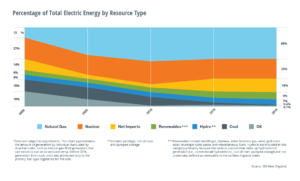In the Feltes vs. Volinsky fight over natural gas, Feltes is right
The two candidates seeking the Democratic nomination for governor are engaged in a heated dispute over natural gas. Though both support transitioning to 100% “clean energy,” state Sen. Dan Feltes would use natural gas in the transition; Executive Councilor Volinsky would not.
Feltes would rely on natural gas as a bridge fuel between dirtier-burning fossil fuels (coal and oil) and energy sources that emit no greenhouse gasses.
Volinsky opposes the use of natural gas in any circumstances. He portrays any use of natural gas as a win for fossil fuel companies and a loss for the environment.
The historical record shows the opposite to be true.
Last year, the International Energy Agency released a report on the environmental benefits of replacing coal with natural gas, showing that the switch has produced enormous environmental benefits.
“Since 2010, coal-to-gas switching has saved around 500 million tonnes of CO2 – an effect equivalent to putting an extra 200 million EVs running on zero-carbon electricity on the road over the same period.” (EV = electric vehicle.)
Continued replacement of coal with natural gas would produce further emission reductions, the IEA report concluded.
“Given the time it takes to build up new renewables and to implement energy efficiency improvements, this also represents a potential quick win for emissions reductions. There is potential in today’s power sector to reduce up to 1.2 gigatonnes of CO2 emissions by switching from coal to existing gas-fired plants, if relative prices and regulation support this potential. The vast majority of this potential lies in the United States and in Europe. Doing so would bring down global power sector emissions by 10% and total energy-related CO2 emissions by 4%.”
The IEA report found that “on average, coal-to-gas switching reduces emissions by 50% when producing electricity and by 33% when providing heat.”
In New Hampshire, coal is still used to produce electricity during periods of peak demand in summer and winter. The state has two of the only three remaining coal-fired plants in New England. Relying on natural gas instead of coal for those peak-use plant firings would bring a quick 50% drop in emissions during those periods.
This emissions reduction would not require waiting for green energy production to scale up. It can be had just by increasing the use of natural gas, which emits almost 100 pounds less carbon dioxide per BTU than the cleanest-burning coal.
Aside from electricity generation, more natural gas would help New Hampshire reduce its reliance on heating oil, which emits 44 pounds more carbon dioxide per BTU than natural gas. Two-fifths of New Hampshire homes are heated with oil, the second-highest portion in the nation (Maine is first.)
More natural gas distribution lines would provide more homes with the ability to switch from oil to gas, which is both cheaper and cleaner. Consumers would save money and reduce emissions. But these distribution lines are routinely opposed by environmental activists.
Natural gas was made cheap and plentiful by the fracking revolution, which was a private-sector innovation no government regulator had thought to prevent. Yet the cleaner fuel often can’t get to consumers because of regulations and political activism, forcing New Hampshire to rely on dirtier coal and gas.
Sen. Feltes is right that using more gas now would reduce both emissions and consumer costs. This is not theoretical. Government data show that it’s already happened.
From 1990-2017, New Hampshire’s energy-generated carbon emissions fell by 8.4% and the carbon intensity of the state’s energy supply fell by 29%, U.S. Energy Information Administration data show.
The market-based transition to natural gas explains the bulk of that reduction, with a slower growth in renewable generation explaining a smaller portion.
As regional power grid operator ISO New England states in its most recent report on New England’s energy mix:
“When the wholesale markets opened to competition, private companies invested billions of dollars in the development of natural-gas-fired power plants because they used advanced technology that made them run efficiently; were relatively inexpensive to build, site, and interconnect; and their lower carbon emissions compared to coal and oil helped the region meet state environmental policies. As nearby shale gas emerged as an inexpensive and plentiful fuel resource in the 2008 timeframe, natural gas generators became the go-to resource for New England, clearing as the largest resource type in the market year after year. Nearly half of the region’s electric generating capacity uses natural gas as its primary fuel (about 15,000 MW), and natural-gas-fired power plants produce about 40% of the grid electricity consumed in a year.”
The chart below, from ISO New England’s report, shows how natural gas grew into the region’s dominant energy source, pushing out dirtier-burning coal and oil.

Aspiring to end the use of fossil fuels is fine. A realistic approach will get us there faster than one based on green fantasies.
Innovation is making alternative energy sources cheaper and is improving battery technology. Some day, we might have the ability to generate large amounts of wind and solar power and store it for use in cloudy and windless periods. But tomorrow won’t be that day.
In the meantime, natural gas is reliable, storable, affordable, and cleaner than other fossil fuels. There is a lot to dislike about Feltes’ energy plan, but to his credit he recognizes the practical environmental gains that can be made by relying on natural gas for now.



